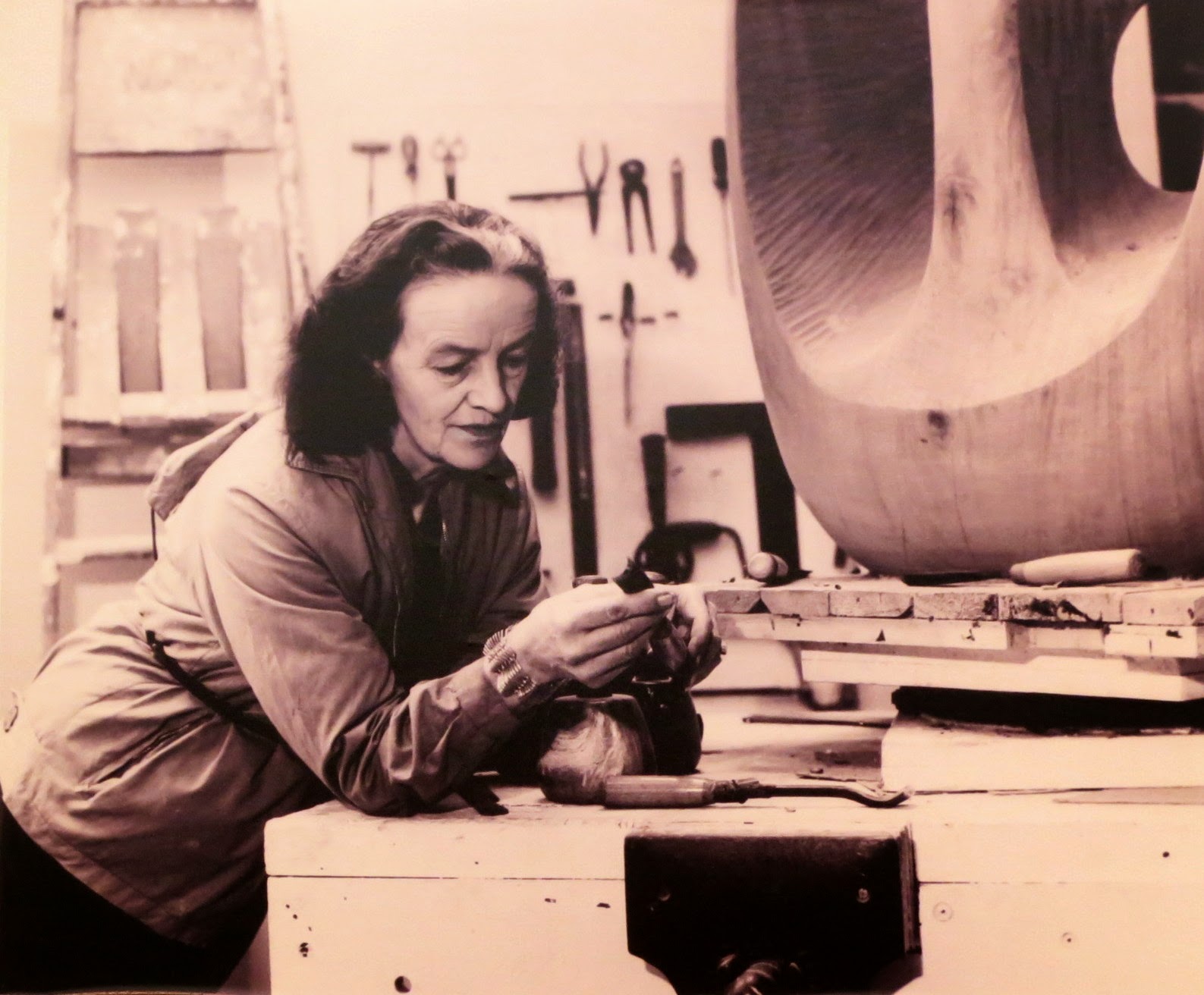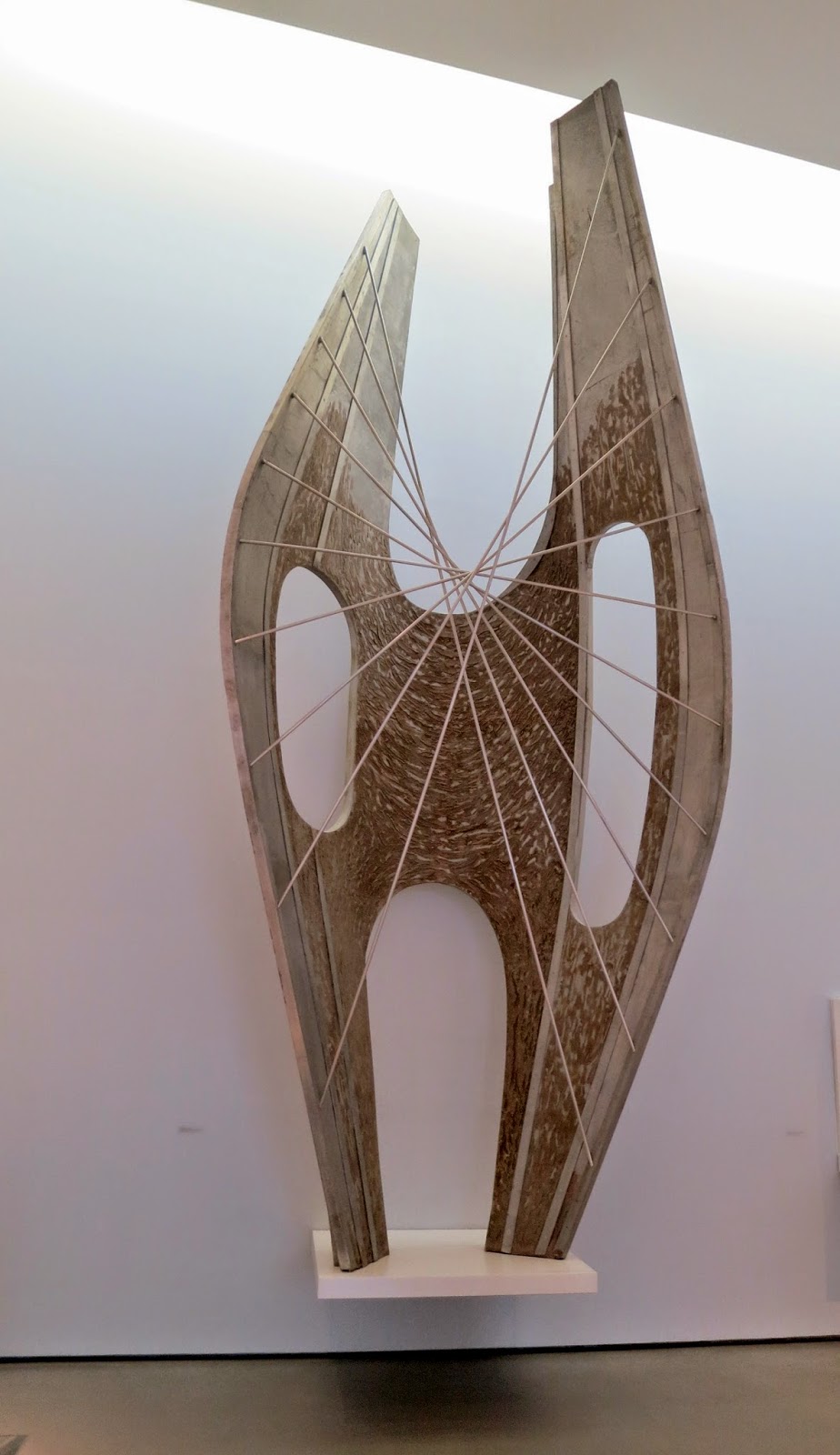Lynda Benglis
at the Hepworth, Wakefield.
Benglis is most well known for a piece of work she did 40 years ago when she posed naked and oiled, wearing just a pair of sunglasses and yielding a double-headed, oversized dildo, intending it for publication in Artforum magazine. When the magazine declined to publish the image, Benglis paid for advertising space. Outrage followed when the advert appeared and five editors resigned. In response to episode, Benglis made five bronze casts of the dildo which she titled
Smile.
An explicit parody of gendered relationships, of the tradition of the 'pin-up' girl images in magazines, and a confrontation of the overt male bias in the art establishment, this was an iconic work, and a good example of the 'culture wars' that raged in America during the 70s and 80s.
The photographer Cindy Sherman has described her college-age encounter with the Artforum ad in all its audacity, as
'one of the most pivotal moments of my career'
This was not typical of her work before or since, however. Working across a range of materials, ranging from beeswax, rubber, polyurethane, bronze, cloth, paper and ceramics, Benglis creates abstract sculptures which explore the physicality of form and how it affects the viewer. Her approach to art making is process-oriented, challenging the traditions of sculpture and painting, with a unique approach to form exploring the physical dialogue between work and viewer.
Benglis emerged as part of a generation of artists forging new approaches to art in the wake of Abstract Expressioism, Minimalism and Pop Art. Her work has challenged the status quo and she has produced some of the most iconic works of art from the 20th century. Yet, like every woman throughout history she has been marginalised and her place in contemporary art history has been neglected. Her influence can be seen in the work of many younger artists working today: the plastic 'blobs' of Roxy Paine; the sexually suggestive props of Matthew Barney; the floor pieces of Polly Apfelbaum; the ambiguous shapes created by Franz West; the work of Cindy Sherman.
Fallen Paintings:
These poured latex sculptures one-upped Jackson Pollock's action paintings in the late 1960s. She poured pools of swirling pigmented latex directly on the floor, obscuring the distinction between painting and sculpture, bringing painting into architectural space. The importance of process in her work is emphasised here - material, colour and image in one single form in this choreographed process.
Baby Contraband, 1969 (poured pigmented latex)

Rumpled Painting/Caterpillar, 1968
one more view
Polyurathane:
Wing, 1970 (aluminium)
Challenging the rigidity of Minimalism during the 1970s Benglis made several site-specific installations in which she choreographed multiple polyurethane pours that projected out of the wall in dramatic arrangements.
Wing is the only metal cast made from this work nearly all of which was destroyed when the installations were dismantled.
Wing epitomises the idea of the
'frozen gesture', a term Benglis often used to describe her early sculptures. Flows of polyurethane have been seemingly caught in motion, which is emphasised by the work's polished aluminium surface.
Quartered Meteor, 1969/75 (lead)
Like many of her 'pours' from the 60s and 70s this work was cast from an original polyurethane sculpture called
King of Flot (1969) which was formed in the corner of a gallery space. Casting in metal allowed Benglis to preserve the forms and play with the viewer's perception of their materiality. Though solid,
Quartered Meteor's oozing surface, which resembles flowing lava, suggests a permanent liquid state. Its corner placement draws attention to the architecture of the space in which it's installed.
 Come, 1969-74 (cast bronze)
Come, 1969-74 (cast bronze)

The Graces, 2003-05 (cast polyurethane, lead, stainless steel)
The Graces is made from polyurethane which Benglis squirts out of a pressurised can - a gesture that alludes to the act of painting. The material has the ability to both absorb and give off light and as Genglis has observed
: 'I'm after that translucent quality we see in sunsets and sunrises and the moon when it's full. All my ideas come directly from nature'.
Greek influence:

Greece has been an enduring source of inspiration for Benglis. Her father was the son of Greek immigrants from Kastellorizo. As well as drawing from Greece's art and architecture, Benglis finds equal aesthetic inspiration from its culture and traditions listing the
'Caryatids on the Acropolis, the holiday cookies, the braided Easter bread, the gold and gilded elements from the Orthodox religion' as important influences.
Greek motifs appear in different forms in Benglis' work. While her 'sparkle knots' can be read in relation to bodily forms and gestures, Benglis has also likened them to floral wreaths hung on the doors of Greek houses during May Day celebrations. Her gilt 'torso' wall-based sculptures, which are often titled with Greek names such as Minos and Perseus, marry the curves of the human body with references to Greek mythology and Hellenic sculpture, motifs which are also explored in her series of 'pleats' which twist and unfurl into dramatic baroque shapes. Beglis' use of gold in these works suggests both weight and weightlessness, drawing attention to surface while using its reflective qualities to
'conceive form with variations in light'. Her use of precious metal also provokes questions about value, taste and the difference between economic and aesthetic worth.
Proto Knot, 1971 (wire mesh, cotton bunting, plaster gesso and sparkles)
Sparkle Knot IV, 1972 (aluminium screen, bunting, plaster, paint and sparkles)
Bravo, 1972 (stainless steel, copper and Babbitt metal)
Tres, 1976 (wire mesh, cotton bunting, plaster, sprayed aluminium and copper)
Gamma, 1972 (aluminium screen, cotton bunting, acrylic paint, gold enamel and sparkles on plaster)
Siata, 1987-88 (copper over stainless steel)
Her first pleated works were inspired by an exhibition of Aegean art Benglis visited in Paris in 1979.
Moving away from the 'knots' she had been making up until this point, she began to work on this more open, pleated form made from wire screen which she covered in gold leaf and later in sprayed liquid metals. She has cited the gilded icons of the Greek Orthodox tradition as inspiration for these works, alongside references to drapery, flora and fauna and decorative jewellery. The 'pleats' are closely concerned with exploring the forces of movement within sculptural form.
Scarab, 1990, (stainless steel mesh and aluminium)
looking closer
Black Orchid/Stutz Bearcat, 1985, (bronze, mesh wire, zinc, copper and chrome)
Lagniappe I (Orange/Blue), 1978
looking closer
Beatrice, 1979 (chicken wire, plaster, gesso, oil-based sizing and gold leaf)
Minos, 1978 (chicken wire, cotton bunting, plaster, gesso, oil-based sizing and gold leaf)
Primary Structures (Paula's Props), 1975 (lead, aluminium and plaster, plastic plant, live plant and velvet)
The title of the work alludes to a landmark show entitled Primary Structures: younger Amerian and British Sculptors which was a survey of minimalist art featuring almost-exclusively male artists. Benglis' 'mock' installation can be read as a critical response to the machismo of the exhibition. It also functions as a commentary on the nature of sculpture itself, as she was interested in 'the idea of the structure, of object and pedestal'. In its theatrical pairing of classical Greek forms with objects that might be considered kitsch, the work caricatures the appropriation of Greek art as a symbol of aesthetic aspiration.
India:
Since 1979 Genglis has travelled annually to India and often works with paper when she's there.
Untitled, 1970 (encaustic pigmented beeswax and Damar resin on Masonite)
looking closer
Hoofers I and II, 1971-72 (aluminium screen, red cotton bunting, plaster, gesso, acrylic and glitter)
Described as 'Totems', Hoofers draw on a wide range of references, from African art to Barnett Newman's painted 'zips'. Their gaudy surfaces appear to have more affinity with craft and costume than with sculpture and they demonstrate Benglis' ongoing interest in challenging notions of value and taste.
Prey Being, 2000, (coiled aluminium and brass wire, sculpted pigmented abaca paper, pigment and gold leaf flecks) and
Earth Cavern, 2001
looking closer
Zanzidae: Peacock Series, 1979 (wire mesh, enamel, glass and plastic)
Manu Light Vessel I and III, 2009 (wire, electric bulbs, bamboo and recycled handmade cotton Gandhi Ashram paper)
New Mexico:
Benglis travelled to New Mexico in 1993 and has since constructed a studio and dwelling there.
Although she had studied ceramics as a student in the 1960s she only returned to using clay at this time. She uses the coiling method.
Figure 2 and 5, 2009 (bronze, black patina)
Sexual Mockeries:
Between 1972 and 1976 Benglis produced fifteen videos which were made alongside her
'sexual mockeries' series of advertisements and invitation cards in which she performed a series of character tropes, engaging with ideas relating to gender roles and sexual identity.
An Amazing Bow-Wow, 1976, video (image taken from
here )
This body of work anticipates Cindy Sherman's work by a number of years.
Female Sensibility, (1973), video
Female Sensibility is one of Benglis' most iconic videos. It depicts Benglis with fellow artist Marilyn Lenkowsky as they touch, lick and kiss each other in a tightly-focused frame. This erotically-charged scene is accompanied by a soundtrack of collaged radio broadcasts, many of which include men making patronising or dismissive references to women.
Female Sensibility creates a space in which the male presence is made redundant and marginalised sexualities are given airtime. The tightly cropped frame of video occasionally renders the subjects as abstract shapes and the continued gesture of touching casts the bodies of the protagonists as sculptural forms.
Sources:
Information provided by the gallery and extensive reading and research.






















































































